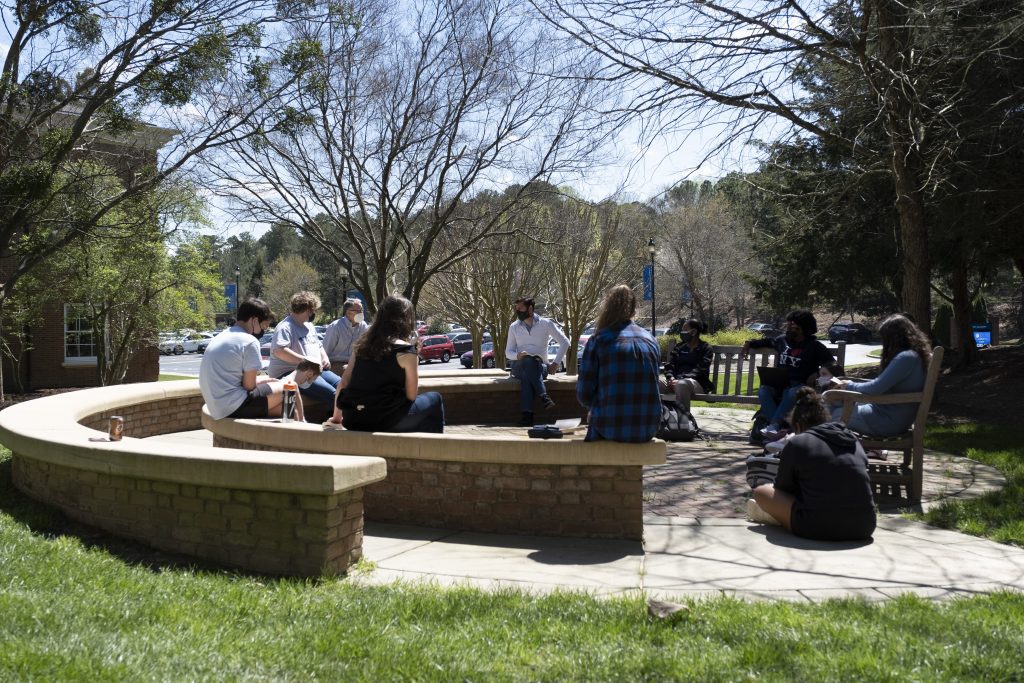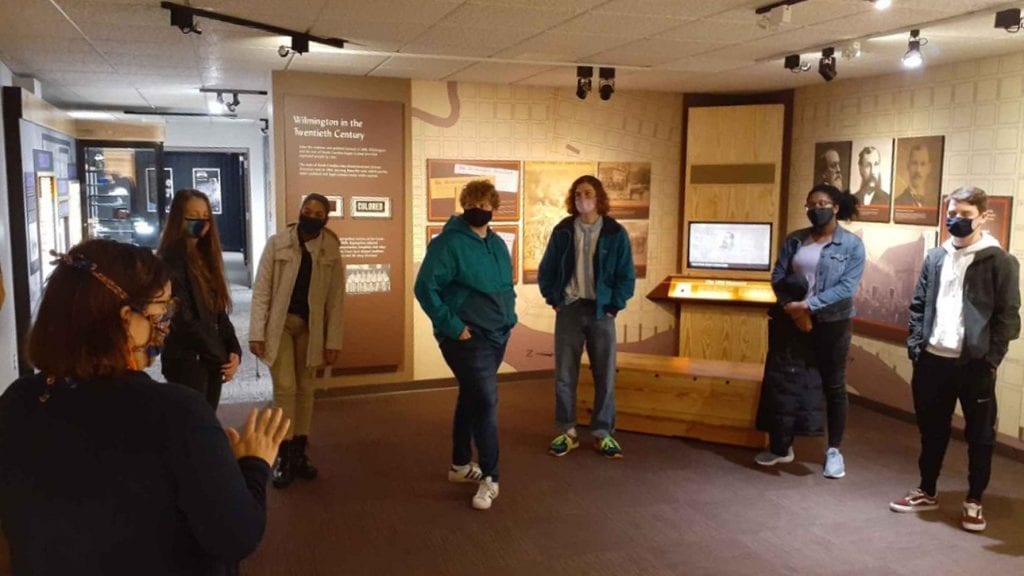Late last summer, as our nation grappled with the longstanding effects of institutionalized racism and racial inequity, CA’s leadership posed bold questions: how can we empower and encourage our students to delve deeper into the complex issues playing out so vividly in the headlines? How can we inspire and develop the next generation of leaders who might help move our country towards a more equitable future?
From our Center for Community Engagement came one answer: a new, year-long, experimental, and expeditionary cross-grade program—the Leadership During Crisis Program—designed to experientially and intellectually immerse students in the complex intersections of history, inequity, social change, anti-racism, and leadership.
“We wanted to drop students into the middle of a deep, wide complex debate about what this country is, what it wants to be, and how leadership can help it move toward those ideals,” explains Dr. Michael McElreath, CA’s Director of Experiential Learning.
“I sketched out an idea to use the pandemic and the fight for Black justice as focal points—as windows into other crises in American history—to better understand how leaders reacted. We’d investigate how those reactions shaped the ‘story of America,’ and what this next generation of leaders—our students—could learn about leadership from those choices, both good and bad.”
As students would be grappling with traumatic histories and events, creating an atmosphere of trust—one in which students felt comfortable sharing their authentic selves and experiences—was paramount, but not without challenge.
“For our students to get the most out of the experience—to be able to thoroughly explore some nuanced and difficult moments and have the chance to learn from each other’s perspectives and experiences—I knew they had to meet face-to-face,” McElreath shares with a sigh. “But at that moment, given COVID, it was obvious that we were not going to hold in-person classes any time soon.”
Putting it together
The solution was something radical: program members—students and faculty alike—would become a distinct and mobile learning community. They would meet on-campus for multiple periods, multiple days each week, and participate in expeditionary field trips (with careful COVID protocols in place, of course), while their Upper School peers remained virtual.
“A self-contained ‘school within a school’ was an exciting idea we’d talked about but never tackled before now,” says McElreath. “It seemed the best way to give the students the chance to dive deep into all of these experiences, make meaningful connections, and come out of the class with a sense of purpose.”
Partnering with Upper School English teacher and Entrepreneurship Director Palmer Seeley, McElreath and Seeley crafted an ambitious interdisciplinary curriculum that spanned social studies, social activism, art as a social practice, and English literature (students still attended regular math and science classes, which fell outside of the program’s scope).
In collegiate seminar-style discussions designed to amplify peer learning opportunities, students explored a variety of works of non-fiction and historical fiction. Together, they unpacked American history from multiple viewpoints—including their own—and discovered narratives that were often at stark odds with the sanitized and simplified story often presented as the American experience.
The group delved into the racial violence woven throughout American history with Ta-Nehisi Coates’s Between the World and Me. They gained rich insights into the complexity and intersectionality of race, gender, and class relations in America via the 17th century slave trade in Toni Morrison’s A Mercy. Ibram Kendi’s personal tale of racism’s toxic effects—How to Be an Antiracist—offered a call to action for systemic change. These and other books provided critical context for the events and places the students were exploring and experiencing firsthand.
Indeed, beyond books and classroom discussion, expeditionary firsthand learning was a crucial element of the program. The group frequently traveled within North Carolina, visiting the State Capitol grounds to see where recently-removed Confederate monuments once stood, to Civil War battlefields, and the site of the 1898 Wilmington coup by white supremacists against the elected leaders of the then-majority Black city.
“Getting out of the classroom and to the places where history happened makes the events and their effects on American society tangible to students. It was critical to the program experience. Being in those places allows us to develop a personal link to history and empathy for the people who lived it—it’s no longer just a fact in a book or an image on a screen; you can imagine what it would have been like to live it yourself,” says McElreath.
“We also visited several sites where later generations have marked historical events in a variety of ways—and not always honestly,” he continues. “Discussions about why and how those with power sometimes attempt to weaponize history in the service of maintaining power was an important part of our discussions about leadership this year.”
Leaning in
In all aspects of the program, students were encouraged to take the lead—to investigate, interrogate, and draw connections about what they were learning through the lens of their own varied experiences and perspectives. “Being forced to make the connections ourselves helped us better understand exactly what happened in the past and how it came about,” shares Maris James ’23.
“Going into this class, the only thing we had in common was that we all went to the same school. We all brought our different experiences and perspectives into this class, which definitely shaped the way each of us analyzed history. While the course was based on a common set of facts, what we learned about leadership traits and how we can implement those into our own lives was drawn from our own experiences and what we—as individuals—see every day.”
Peer learning and peer mentorship opportunities were carefully and purposefully cultivated, down to the very organizational structures and assignments chosen for the program. Students often assumed the role of teacher, conducting independent research projects on historical events and figures and then teaching it to their peers as formal lessons.
“These student-led sessions were a vital part of the program concept,” says McElreath. “Preparing to teach a lesson requires mastery of the topic. Peer teaching ensures that students are engaged and invested in the shared experience of learning.”
And, it worked. More often than not, the students were so caught-up in their conversations that discussions spilled out of the classroom, onto the Quad during lunch, and into the after-school hours. “There was one day, early on, when we all just sat together at lunch and kept the conversation going,” shares Clay Thornton ’21. “From that point on, we all started eating together so we could keep talking about what we had said in class.”
“Peer mentorship was critical for the program. It’s not enough for the students to learn about leadership,” offers Seeley. “They needed the opportunity—and the environment—that let them lead the conversation. It had to feel organic, relevant, and have the right balance of guidance and agency. It was important that Michael and I be part of the community but to do so by guiding discussions, not leading them.”
That “guide-on-the-side” approach was well received by students and faculty alike, solidifying the bonds amongst group members. “We felt like a community. Dr. Mac and Mr. Seeley were in the class with us—even if they were sometimes 200 pages ahead in the book,” laughs Sydney Ross ’23. “It felt so good to have the teachers involved. The chance to be real when we talked about these really difficult events was so helpful.”
The strategic decision to make the program cross-grade—comprised of sophomores, juniors, and seniors, many of whom had never been in the same room—was similarly instrumental in fostering an engaging peer-led environment.
“The seniors had two years’ more knowledge, experiences, and skills to draw upon, but the sophomores were at a point in their high school careers that they could take more academic risk,” explains Seeley. “Taking those risks can provide them opportunities to expand their understanding of the world in ways that most people don’t get until college or later.”
Purposefully including students at different moments in their respective learning journeys proved lucrative, encouraging personal growth and reflection as students became sounding boards and learning resources for each other. Together, they developed a more nuanced and multifaceted understanding, not only of the historical and contemporary moments they were exploring and experiencing, but of each other.
“The year let me get to know the voices and perspectives of my peers in the class on a much deeper level than in my other courses,” says Kate Sandreuter ’23. “I gained confidence for speaking up in class and got to explore issues on a deeper level by listening to the different perspectives of other people experiencing the same thing.”
The year-long format allowed the students time to develop crucial nuance. “You might think that our opinions over the year would have become more homogenous,” reflects Eli Weinstein ’21. “As the class went on, however, I realized just how different each of us was. And that, in turn, changed the way I saw the American story. I realize now how it has been co-opted time and again; the fact is, the American story isn’t one thing.”
The flexible, experiential format also supported different learning styles. “As someone who struggles with memorizing facts and dates, this is one of those courses where—because we’re so discussion focused—we get to move beyond the what and when, and focus more on the who and the why, and how it connects with the things that we’re living through,” shares Lexie Davilla ’23.
Living history
It was that relaxed, flexible structure that allowed the class to pivot as history unfolded during the U.S. Capitol riot on January 6, 2021. “When January 6 happened, it felt like it was the logical next part of where the discussion had to go,” says McElreath. “It brought home, in realtime, just how quickly a single event can affect the course of history. And it gave the students the opportunity to lead informal discussions with their peers who weren’t part of the program.”
“In that moment, it was almost like Dr. Mac and Mr. Seeley were in class with us,” says Thornton. “But they were also guides—helping point out the things that we, as high school students, might not have the life experience to pick up on or contextualize. It helped me process all the questions I had swirling in my mind, and it’s helped, since then, when talking to my friends from outside the program.”
While the academic year and formal program might have drawn to an end, the work begun in the class is far from over. “Ultimately these debates, these conversations about American identity are not going to end,” offers McElreath. “But that’s true for the nation, as well. We had that conversation for nine months. We may have finished the class, but, hopefully, the students are not finished with the conversation.”
They certainly aren’t. Already, McElreath and Seeley’s students have been incubating ways that they can turn their newly honed leadership skills to personal interests, both on campus and beyond. To name just a few: Eli Weinstein and Jared Seidel are exploring a re-branding of anti-fascism in hopes of helping to effectively stem the rising global tides of fascism; Bela Chandler and Jenna Pullen have created an animal wellness awareness campaign that aired on the Middle School’s CAST News; and Lexie Davila utilized educational resources about LGBTQIA+ issues created by Leadership During Crisis classmate classmate Christina Polge to facilitate the “Introduction to Gender & Sexuality” workshop during YES! (What’s YES! you ask? Just read on to find out.)




